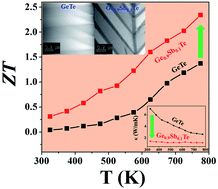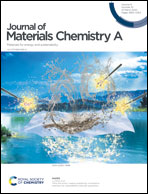Synergistic optimization of thermoelectric performance of Sb doped GeTe with a strained domain and domain boundaries†
Abstract
In addition to the Ge-vacancy control of GeTe, the antimony (Sb) substitution of GeTe for the improvement of thermoelectric performance is explored for Ge1−xSbxTe with x = 0.08–0.12. The concomitant carrier concentration (n) and the aliovalent Sb ion substitution led to an optimal doping level of x = 0.10 to show ZT ∼ 2.35 near ∼800 K, which is significantly higher than those single- and multi-element substitution studies of the GeTe system reported in the literature. In addition, Ge0.9Sb0.1Te demonstrates an impressively high power factor of ∼36 μW cm−1 K−2 and a low thermal conductivity of ∼1.1 W m−1 K−1 at 800 K. The enhanced ZT level for Ge0.9Sb0.1Te is explained through a systematic investigation of micro-structural change and strain analysis from room temperature to 800 K. A significant reduction of lattice thermal conductivity (κlat) is identified and explained by the Sb substitution-introduced strained and widened domain boundaries for the herringbone domain structure of Ge0.9Sb0.1Te. The Sb substitution created multiple forms of strain near the defect centre, the herringbone domain structure, and widened tensile/compressive domain boundaries to support phonon scattering that covers a wide frequency range of the phonon spectrum to reduce lattice thermal conductivity effectively.



 Please wait while we load your content...
Please wait while we load your content...